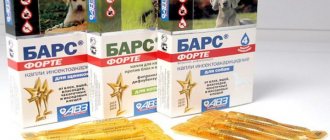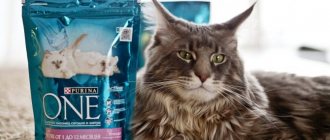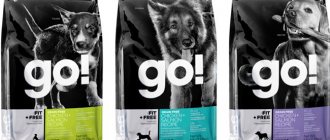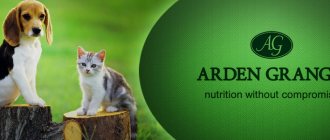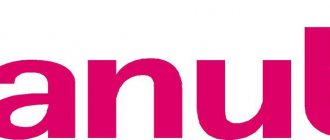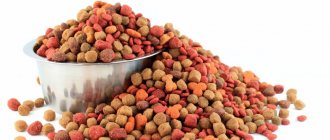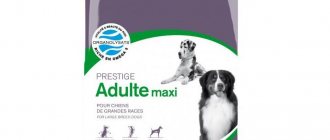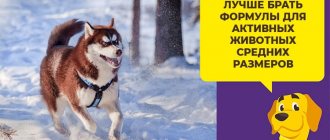Who produces this food?
The official manufacturer of ProPlan is the famous American corporation Nestle Purina PetCare. In Russia, the company Michel and Co. has the rights to represent its interests and sell its goods. Michel & Co. produces for free sale a line of regular foods for puppies, adult dogs and elderly animals. But veterinary rations most often need to be ordered through specialized clinics or directly on the ProPlan website in Russia. In parallel with ProPlan, the Nestle Purina PetCare company sells Darling and Dog Chow, which are less respected among dog breeders.
In our country, the range is not as wide as in the United States of America. But this does not prevent Russian four-legged lovers from choosing completely suitable diets. The manufacturer supplies here ProPlan for small dogs, Purina Pro Plan dog food and other medicinal dog food created under the ProPlan brand, food for puppies under one year old and the live weight of an adult animal, as well as ProPlan for medium breeds.
Food range
When producing Pro Plan, all the anatomical and physiological characteristics of dogs at different stages of their life are taken into account. That is why the range of food for dogs from this company is so diverse. The line is expressed in three categories of dog food: for puppies up to one year old, for pets from one to seven years old, and also for aging dogs over seven years old. There are also special diets for animals with health conditions.
Puppy food
ProPlan is intended for feeding puppies. And when choosing food, it is important to consider what weight category the adult pet will belong to, as well as how things are with the health of the young animal. Small & Mini Puppy is used for feeding small breed puppies, Medium Puppy - for medium puppies, Large Puppy Robust and Large Puppy Athletic - Pro Plan food for large dogs. There are separate diets for animals with painful digestive tracts and skin.
Diet for adult dogs
The range for adult dogs from the ProPlan company is divided into series. This gradation allows you to choose food depending on the needs of the dog, its breed, size and health status. Adult diets are suitable for animals with a sensitive digestive tract (the required variety is called Proplan Gastro Intensive) or dermatological problems (Purina ProPlan is divided into several varieties depending on the specific problem and the size of the animal). Lines have been developed for sterilized overweight animals; for powerful, athletic dogs with large body weight and developed muscles.
For older dogs
The composition of dry food from the ProPlan company is hypoallergenic, so it can also be given to elderly dogs. It is only important to choose the right variety. There are three varieties for mature pets. The first is suitable for older animals from nine years of age and those belonging to dwarf breeds. The second is for small breeds over seven years old, and the third is for medium and large dogs over seven years old with problem skin.
Pro Plan food line
The manufacturer offers a large selection of feed:
- OPTISTART. For pets up to 1 year.
- OPTIWEIGHT. Suitable for obese dogs and sterilized pets.
- OPTIDIGEST. With a weak gastrointestinal tract.
- OPTIBALANCE. A universal product with a selection of nutritional components to suit the requirements of the breed.
- OPTIAGE. For old animals.
- OPTIDERMA. For a beautiful coat.
- OPTIPOWER. Designed for working pets.
- DUO DELICE. Suitable for animals that do not eat well. The product combines two types of granules.
In addition, the line is complemented by products that help clean teeth from plaque and treats.
OPTIWEIGHT
OPTIPOWER
OPTIBALANCE
OPTISTART
For large breeds
For large dogs, it is important to maintain muscle mass without gaining weight. The following products have been developed for them:
- Large Adult Optibalance with chicken. Suitable for dogs from 1 year. Includes two types for stocky and graceful animals.
- Medium & Large Adult 7+ Optiage. Designed for animals over 7 years old.
- Medium Adult Optibalance. Designed for dogs of medium build.
For small breeds
Small dogs also need proteins, because they are also carnivores. For small breeds, the manufacturer offers the following products:
- Small & Mini Adult Optibalance. The composition includes chicken (20%) and rice (7%).
- Small & Mini Adult 9+ Optiage. Designed for older animals.
- Small & Mini Adult Sensitive Skin. Hypoallergenic product.
- Small & Mini Adult Optidigest. Designed to restore intestinal function.
For puppies
The first year of an animal’s life is the most critical in terms of nutrition. Purina's puppy line contains colostrum. The following types are available for sale:
- Large Puppy. For large breed puppies. There is a division according to the pet's equipment.
- Medium Puppy. Food for medium size with the same ingredients.
- Small & Mini Puppy. Differs in the volume of ingredients. Designed for small dogs.
What does Pro Plan contain?
Most of the food from the ProPlan line is manufactured in Russia, at official production in the village of Vorsino in the Kaluga region. This gives owners confidence in the quality and natural origin of the ingredients. The naturalness of Pro Plan is high. And the recipes of Russian lines differ from those accepted in the West. Localization has especially changed wet food, and some dry formulas, and this has led to the appearance of unpleasant features.
- The main component of dog food should be meat. But chicken (14%), lamb (19%), turkey (22%) are not so concentrated in ProPlan feeds to speak of a serious beneficial effect on the animal.
- Salmon, which is part of a large number of diets for adult dogs, contains a high concentration of Omega-3 and is 80% water.
- Dry salmon protein is added separately. This allows you to provide the dog with the necessary amount of protein. Pure dry protein is extracted from salmon cutting waste through chemical processing.
- Dry animal protein (mostly chicken) is also added. It also contains protein, and is a completely desirable component of a dog’s diet, but its location at the top of the list indicates its overabundance.
- Beetroot pulp is used to balance the animal's blood sugar levels. But some veterinarians insist that this is simply filler for the volume and weight of the pack.
- Wheat increases the caloric value of the diet. It quite correctly affects digestion and speeds up metabolic processes.
- Corn is often used in the production of Purina ProPlan dog food. This is due to the fact that corn is an easily digestible, cheap source of carbohydrates and a stomach filler that greatly increases satiety.
- Rice supplies the animal with complex carbohydrates and increases the calorie content of the product. It, like corn, does not harm the dog, but it also does not provide much benefit to its health. Especially in diets for sterilized dogs.
- Animal fat is one of the worst ingredients in Pro Plan products. The fact is that this formulation can hide the organic remains of any animal, even waste from a slaughterhouse or simple expired food.
- Another controversial component of the composition is dietary fiber. Under this name lies ordinary cellulose. It is easy to understand that the dog does not get any benefit from the consumables in paper production.
- Monosodium glutamate, hidden under the term “flavoured feed additive”, is generally not recommended to be given to four-legged friends, allergies and side effects are too likely. But it’s not just Pro Plan that adds it to feed.
Thus, analysis of the composition indicates inconsistent quality of the feed. Some components, the existence of which even the company itself does not deny, are of unknown origin. This suggests that if something happens to the dog, you are unlikely to receive a constructive answer about the quality of the product. Then which food is better for dogs: ProPlan or Royal Canin? If we compare the composition specifically, the advantage is not on the side of the products of Michel and Co.
Pro Plan Dog Food Review
There are many types of plan.
But most of them are of the same type, differing little from each other. To understand what this brand represents, let’s look at the most popular diet – Pro Plan OptiBalance for adult dogs of medium breeds. The basis of any food is the first 6 ingredients, listed in the composition by percentage in descending order.
For the species in question it is:
- Chicken (20%). Source of animal protein. However, it is not indicated which parts of the carcasses are used: it can be either fillets or second-class raw materials - wings, necks, bones. In addition, the meat is not fresh - otherwise the company would have labeled it “fresh” or at least “fresh frozen”.
- Wheat. No percentage specified. But we can assume that the mass fraction of the ingredient is large, because he comes second on the list. Cheap raw materials that cause allergies in dogs.
- Dry poultry protein. This name refers to dried and processed meat. This is a good component, but there are nuances: the percentage content, the specific type of bird and the parts of the carcasses that were used to obtain dry protein are not indicated.
- Corn. Its properties are similar to wheat. Low-grade raw materials cause allergies and are a source of excess calories and vegetable protein. It is added simply to “stuff” drying and make it cheaper.
- Rice (9%). A healthy cereal that is often used even in super-premium and holistic diets. But it is not enough compared to other grain crops.
- Animal fat. Not the best source of energy, increases the calorie content of the feed and impairs its digestibility.
Judging by the main components of Pro Plan OptiBalance Medium Adult, the food barely reaches the premium class. It contains more plant ingredients than animal ingredients, the quality of the raw materials is unknown, and there are allergenic products.
If we analyze the composition further, we will discover other interesting points:
- Split titles. This term hides the designation of the same product under different names. This is done in order to visually reduce the percentage of unwanted components (vegetable) and bring the desired ones (meat) to the first place in the composition. So, in OptiBalance Medium Adult it is corn gluten (essentially the same corn, which is already listed in 4th place) and wheat gluten (another name for wheat, No. 2 on the list). If you combine these ingredients, their share will outweigh the volume of the bird.
- There is a flavoring food additive. Used to improve the smell and taste of granules and make them more attractive to pets. In addition, dogs eat more food with such additives than normal - therefore, the food is consumed faster, and the owner overpays.
- Marketing gimmicks with names. In English, 2 ingredients are indicated: “Soya Meal” (“soy flour”) and “Dehydrated soya protein” (“dried soy protein”). But in the Russian-language version of the composition, instead of them, the term “products of processing plant raw materials” appears. This move helps hide the presence of soy in the granules.
- Egg powder. On the one hand, it is a good source of calcium, potassium, sulfur, sodium and vitamins (A, C, E, D, group B). On the other hand, the product often causes allergies.
Among the positive aspects, one can note the presence of dry beet pulp (helps to establish intestinal motility), fish oil, antioxidants, mineral and vitamin supplements.
But in general, Purina Pro Plan OptiBalance for adult dogs of medium breeds is not the best food among premium diets.
Types and types of feed
Proplan dog food has 2 lines: everyday and veterinary. More often they take food from the first variety: they are aimed at maintaining general health and preventing pathologies. Diets from the second category are intended to treat specific diseases. Regardless of the type, the average price of a 3 kg drying package is 1,050 rubles.
The daily line is represented by the following types:
- OPTISTART . Variety for puppies of small, medium and large breeds. Enriched with colostrum: the ingredient helps strengthen the immune system.
- OPTIWEIGHT . Designed for overweight pets and sterilized dogs: high in protein and low in fat (47% less than other diets according to the manufacturer). There is a universal type for small breeds.
- OPTIDIGEST . Designed for dogs with sensitive digestion. There are subspecies for puppies and adult dogs of different sizes.
- OPTIBALANCE . Universal line: each type contains balanced nutrients selected for the specific breed and body type of the pet.
- OPTIAGE . For older pets. Helps improve the well-being, physical and mental endurance of elderly animals. Available in 2 types: for large breeds and medium-sized dogs over 7 years old, as well as for small breed dogs over 9 years old.
- OPTIDERMA . Designed to prevent skin diseases and maintain the beauty of the coat. Available for pets of different ages and breeds.
- OPTIPOWER . Designed for working, active dogs: increases the pet's endurance and its ability to recover.
- DUO DÉLICE . Food for picky pets: combines two types of granules - crispy kibble and soft kibble. Helps improve the condition of teeth and gastrointestinal tract.
Also in the daily line there are toothpick delicacies for cleaning plaque and treats in the form of cookies.
In addition to dry food, the veterinary diet also includes wet food - canned food. These include:
- HP: HEPATIC – for liver dysfunction;
- JM: JOINT MOBILITY – support for sore joints;
- HA: HYPOALLERGENIC – Pro Plan hypoallergenic is intended for the diagnosis and diet therapy of food intolerance;
- UR: URINARY – prevention of urolithiasis;
- DRM: DERMATOSIS – for diseases of the skin and coat;
- EN: GASTROINTESTINAL – for disorders of the digestive tract;
- NF: RENAL FUNCTION – for kidney diseases;
- OM: OBESITY MANAGEMENT – for weight correction.
Feed composition
The composition of Pro Plan feed is the same. Most types of drying contain the following components:
- Chicken, turkey, salmon or beef meat - from 14% to 21%. Good source of animal protein. However, keep in mind that the volume of raw materials is indicated - after heat treatment, only 20-30% of it will remain. In addition, the parts of the carcasses that are used to prepare pellets are not indicated.
- Dry poultry, fish or lamb protein. Obtained after drying and processing carcasses. This ingredient complements the previous one: without it, the volume of meat would be extremely small.
- Wheat and corn. Cereals, sources of vegetable protein. These are cheap components that manufacturers use to dilute drying: cereals, vegetables and, especially, meat are many times more expensive. These ingredients are extremely undesirable on the menu of carnivores.
- Corn and wheat gluten. A product of processing grains into starch. Essentially the same grain, just under a different name. By designating this component under a different name, the manufacturer artificially lowers the total volume of plant components in the diet.
- Animal fat. Not the most useful source of energy. In addition, its origin is not indicated: it could be rendered fat from poultry carcasses, or slaughterhouse waste and other second-rate products.
- Rice – from 4% to 16%. A good cereal that is easily digestible and has high nutritional value. If the manufacturer had made it the only plant component, rather than diluting the granules with wheat and corn, the food would have been much better.
- Products of processing of plant raw materials. In the review of OptiBalance Medium Adult z it is already indicated that soy is hidden under this name. Keep in mind that this product has low biological value, it is poorly digested and poorly absorbed, causes gas formation and fermentation in the intestines, and disrupts the functioning of the digestive tract.
- Flavoring feed additive. This is nothing more than monosodium glutamate or E621. Designed to enhance flavor and make it more palatable. Its presence is not acceptable in good animal diets.
- Dry beet pulp. Source of fiber. Improves intestinal motility, promotes food digestion.
- Egg powder. Obtained from dehydrated eggs. Provides the body with vitamins and minerals for healthy joints, skin and coat. However, it often provokes allergic reactions.
- Fish fat. An excellent source of Omega-3 and Omega-6 fatty acids.
- Minerals and vitamins. Chemical additives. All manufacturers use them to balance diets.
- Antioxidants are tocopherols of natural origin. Vitamin E is hidden under this name. It is a good natural preservative that preserves the granules and avoids the use of artificial additives.
The Pro Plan line includes grain-free varieties. They replace corn, wheat and rice with:
- Pea starch. Obtained from dried pea grains. Inexpensive filler and source of carbohydrates. Not good for dogs, used to make it cheaper. In addition, it ranks third after meat and dry poultry protein, which means its volume is high.
- Cassava – 12%. It is also known as cassava or tapioca starch. It is obtained from the tubers of a plant with properties similar to potatoes. Like any starch, it is not beneficial for dogs, especially in large quantities. Used as a cheap ballast substance.
- Pea protein. Another ingredient obtained from dried peas. Less common than soy, it causes allergies and serves as a cheap source of protein. Undesirable product in food for carnivores.
- Dried peas. Source of protein, carbohydrates, fiber, amino acids. Has a lower glycemic index than cereals. Useful in small quantities, helps improve digestion.
- Hydrolyzed animal proteins. It is obtained by treating animal waste with enzymes that break down proteins and then drying it. More of a flavoring additive than a useful component. In addition, it is not known from what products the substance is obtained.
- Soy flour. Soybean derivative, cheap vegetable filler. Used to improve taste, satiety and increase protein levels with a low volume of animal ingredients. The disadvantages are the same as those of soy.
Purina adds useful nutritional supplements to some types of food: colostrum (0.1%), amino acids, L-carnitine, yeast. But their share is either not indicated or small. Therefore, it is impossible to determine whether these components can somehow affect the body and improve the health of the pet.
I reviewed the daily food line. Their composition is described in detail. However, not every component has a percentage listed. There are also no descriptions of the exact type of raw meat. These factors cast doubt on the quality of Purina diets.
It is impossible to analyze the veterinary diet, because... The manufacturer does not indicate the ingredients, but only provides percentage characteristics of nutrients. As an example, I provide data from the official website of the Pro Plan NF Renal Function diet:
Advantages and disadvantages
Benefits of Pro Plan food for dogs:
- a good amount of animal proteins for a premium diet;
- there are useful plant components - rice, peas, beet pulp;
- enriched with useful substances: vitamins, minerals, colostrum, brewer's yeast, carnitine;
- sold in any veterinary clinic, pet store and even in grocery markets;
- preserved with tocopherols;
- there are many types for dogs of different ages, breeds and with different needs;
- availability of a veterinary line.
Flaws:
- no fresh meat products;
- the percentage of each ingredient is not indicated;
- a lot of grain crops - their mass fraction in total exceeds the volume of animal products;
- contains chemical additives to enhance taste and smell;
- there are soybeans, starch, wheat, and corn that are dangerous for dogs;
- confusion with names: split, replacement of names when translating from English into Russian;
- Overpriced for poor content.
Daily norm
Feeding rates recommended by the manufacturer are shown in the tables.
Daily value for puppies:
Feeding rate for adult dogs:
Recommendations for daily feeding of older dogs:
Average values are presented. Feeding rates for different types of feed may differ by several tens of grams. This is due to the individual needs of the animal, its physical characteristics, activity, age, etc.
Advantages and disadvantages
The previous point proves that even reputable dog foods can have negative aspects. Obviously, this food does not belong to the super-premium segment, but it still confirms its premium status. This is why ProPlan is better for dogs than Hills, Dog Chow and similar brands. But to form an objective view of ProPlan, you need to analyze all the pros and cons even before purchasing a trial pack.
Pros:
- The company presents a wide variety of products. It will be possible to choose diets depending on the size of the breed, age, and health characteristics of the animal.
- The assortment includes dry and wet food varieties. And they are all sold in packages of different weights and sizes, which allows you to choose the most optimal nutrition.
- The price, in comparison with other premium products, is quite adequate. You can find dog food costing up to 500 rubles, albeit in small quantities.
- Most feeds, distributed in packages of three kilograms or more, have a fairly small daily consumption. This further reduces the dog owner’s expenses on food.
- Mineral and vitamin complexes are indicated at the very end of the composition, but their quantity is optimal for four-legged pets.
Minuses:
- The composition includes substances that are not beneficial even for a healthy animal. Cellulose and monosodium glutamate can cause irreparable harm to a dog, especially if added to veterinary or dietary food.
- The manufacturer does not confirm or deny this, but a chemical analysis of ProPlan showed that it contains meat by-products. This reduces its nutritional value.
- Quality standards have been changed for our country, and, unfortunately, not for the better. In Russia there are completely different formulations, composition components and concentrations of non-natural substances.
- You can buy specialized medicinal food in a small locality only through a veterinary clinic. And they often add a percentage, so the price of food for sick dogs can be an unpleasant surprise.
- If you do not take into account minerals and vitamins, the diets have a rather poor composition. Too large a percentage of the components are allocated to rice, corn and other banal stomach fillers.
Are there any advantages to ProPlan over other foods?
In order to sensibly assess the quality, you need to understand what class of ProPlan food it is? And the correct answer is indicated by the high market value - these products are classified as premium. Compared to other representatives of this price category, Pro Plan food stands out well. A small norm per day makes such nutrition quite attractive from an economic point of view. But what are the objective advantages of the brand?
Veterinarians from the production have created more than 30 foods for different dogs. This contrast is noticeable when comparing ProPlan with the Chicopee company, which has only 11 items. They also developed a special veterinary diet, which is used by many specialists (it includes foods such as Urinari ProPlan, Joint Mobility, Renal Function, Dental Health, Fortiflora, Hepatic, Gastrointestinal, and so on).
This feature of the feed most fully concerns practice in small towns: ProPlan is one of the most affordable premium feeds. The company's policy is to find an individual approach to dogs with different needs. Therefore, ProPlan has a rather rich mineral composition. Veterinarians note the good content of vitamin E. This company uses about 550 IU/kg, while in diets from Probalance the figure is 10 times less.
Price
Price is one of the main advantages of food from the ProPlan brand. It starts from 300 Russian rubles, which is objectively low for premium products.
- Purina Pro Plan for puppies weighing 700 grams is sold for 300-400 rubles, depending on the additional component. Surprisingly, salmon costs the same as chicken.
- A dry diet for adult dogs with special digestive problems, skin problems, or ordinary dwarf animals is sold for 380 rubles. This is how much a pack weighing 700 grams will cost, but there are discounts when purchasing directly from the manufacturer.
- Dry food with beef, turkey or chicken from Purina Pro Plan Duo Delice for adult dogs costs 420 rubles or more. One pack weighs about 700 grams.
- A 1.5 kilogram pack of dry food for adult dogs with or without health problems will cost around 690-750 Russian rubles.
- Food for puppies, a pack of which weighs 1.5 kilograms, will cost the animal owner 790 rubles. But the feeding table suggests that food consumption will be small.
- Purina Pro Plan Duo Delice dry food for adult dogs of large breeds is sold in packs of 2.5 kilograms. One of these costs 1190 rubles.
- Food for adult and elderly dogs can be purchased at three kilograms. In this case, a pack will cost 1190-1390 rubles or more. A three-kilogram package for puppies costs about the same.
- Larger packs from the regular Pro Plan line weighing 7-14 kilograms with a variety of flavorings are sold for an average of 2790-4690 rubles.
Video: ProPlan dog food, its composition, as well as reviews about this food
Allergy. Is there a way out of the situation?
Food allergies, which manifest themselves in the form of itching, rashes and redness of the skin, do not only affect people. A large number of our pets are also prone to this disease.
Veterinarians cite unfavorable environmental conditions, which reduce the animal’s immunity, as well as low-quality products on their menus as the main reasons for the increasing incidence of food allergies.
Since atopic reactions can be caused by various components, animal feed manufacturers have developed a large number of different hypoallergenic products. For example, the premium class Purina has a Pro Plan line, which includes dry mixtures for dogs of different activity, age and breeds, characterized by sensitive skin OPTIDERMA and digestion OPTIDIGEST . Hills has a Prescription Diet line.
There are specialized clinics all over the world where nutritionists conduct research into the causes of food intolerance in domestic dogs and cats. It has been revealed that the cause of the disease can be long-term consumption of certain types of proteins.
List of foods that most often cause allergies in pets:
- Beef, lamb, pork, chicken;
- Poultry egg;
- Milk products;
- River fish;
- Cereals, corn, soybeans;
- Tomatoes, eggplants.
Low quality ingredients used to make economy-class products can become the root cause of skin and food diseases in pets. Therefore, it is better to purchase products from trusted manufacturers, such as Purina, where the approach to dietary nutrition is scientifically based. Veterinarians and dog breeders around the world speak extremely positively about the hypoallergenic food offered by this manufacturer.
Pro Plan products are considered the best for all ages, sizes and breeds. A varied, balanced diet is offered for small, medium and large breed dogs. The main sources of protein in Purina's allergy-friendly foods are salmon and duck, which are great for pets with skin problems.
Often the reaction is triggered by a specific product, avoiding which can ensure your pet’s well-being. Therefore, manufacturers are developing various product lines that contain the necessary components for the development of the animal and exclude allergens.
Types of food for dogs with food allergies:
- Gluten-free food (does not contain protein of plant origin), this line can also include products that do not contain wheat and corn, but add white or brown rice;
- Food without beef, pork, lamb and chicken. If your pet is intolerant to animal protein, then his diet should be based on easily digestible meat of salmon, lamb, duck or rabbit. It has been proven that such food rarely causes allergies;
- Mono-protein diet, which contains only one type of meat;
- Feed without eggs, milk and yeast. Such products are usually labeled “with a limited number of ingredients”; their composition does not contain products included in the list of the most allergenic.
Veterinary clinics can conduct laboratory tests to identify allergens. The doctor helps you create the right menu or recommends hypoallergenic food that is best suited for the animal depending on its lifestyle, breed and age.
How to choose the right food for your dog?
The basis of a dog’s diet is protein food, these are mainly meat products, which should be at least 65% in the diet of a healthy animal. If an animal is allergic to meat, then hypoallergenic food should consist of horse meat, turkey, duck, rabbit or fish.
The source of energy for a pet is carbohydrates contained in cereals and potatoes. If intolerant, these products are replaced with rice.
Anti-allergenic food should also contain:
- Fiber to normalize intestinal function;
- Vitamins and minerals;
- Medicinal plants that reduce allergic reactions.
A properly selected hypoallergenic diet can help get rid of food allergy symptoms within a few days.
The entire product line from Purina Pro Plan is divided into subsections:
- Food for adult dogs,
- For puppies
- For pets over 7 years old
- Soft food Duo Delice
- Food for animals with health problems
